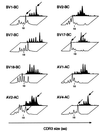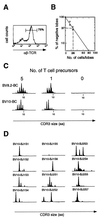Diversity, functionality, and stability of the T cell repertoire derived in vivo from a single human T cell precursor
- PMID: 10618408
- PMCID: PMC26653
- DOI: 10.1073/pnas.97.1.274
Diversity, functionality, and stability of the T cell repertoire derived in vivo from a single human T cell precursor
Abstract
In this report, we have analyzed the human T cell repertoire derived in vivo from a single T cell precursor. A unique case of X-linked severe combined immunodeficiency in which a reverse mutation occurred in an early T cell precursor was analyzed to this end. It was determined that at least 1,000 T cell clones with unique T cell receptor-beta sequences were generated from this precursor. This diversity seems to be stable over time and provides protection from infections in vivo. A similar estimation was obtained in an in vitro murine model of T cell generation from a single cell precursor. Overall, our results document the large diversity potential of T cell precursors and provide a rationale for gene therapy of the block of T cell development.
Figures




References
-
- Davis M M, Bjorkman P J. Nature (London) 1988;334:395–401. - PubMed
-
- Malek T R, Porter B O, He Y W. Immunol Today. 1999;20:71–76. - PubMed
-
- Alt F W, Oltz E M, Young F, Gorman J, Taccioli G, Chen J. Immunol Today. 1992;13:306–314. - PubMed
-
- Sant'Angelo D B, Lucas B, Waterbury P G, Cohen B, Brabb T, Goverman J, Germain R N, Janeway C A., Jr Immunity. 1998;9:179–186. - PubMed
-
- Viret C, Wong S, Janeway C. Immunity. 1999;10:559–568. - PubMed
Publication types
MeSH terms
Substances
LinkOut - more resources
Full Text Sources
Other Literature Sources
Medical

